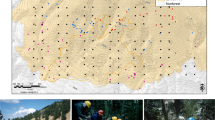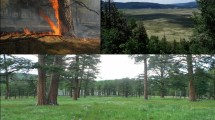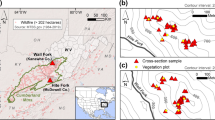Abstract
Vegetation processes in terrestrial ecosystems are closely linked with wildfire regime, but fire histories at the boundary between the Great Basin and Mojave Deserts of North America are relatively sparse. We investigated wildfire regime and its driving factors before and after Euro-American settlement in high-elevation mixed-conifer ecosystems that are found as “mountain islands” in south-eastern Nevada, USA. Field-based results obtained at the Clover Mountains were compared with those already published for Mt. Irish, less than 100 km away, and also to remotely sensed information provided by the LANDFIRE project, which is commonly used for natural resource management. Annually resolved wildfire history at the Clover Mountains was derived back to year 1500 from fire scar samples taken from 139 ponderosa pines (Pinus ponderosa) located in six stands. During the 1785–2007 period, when at least 20 recorder trees (and a total of 241 fire scars) were available, the Clover Mountains were characterized by frequent (mean fire interval <10 years) low-severity fires, half of which scarred more than 10 % of recorder trees. The 1877 and 1946 fires scarred 50 % or more of recorder trees and spread to four out of six sampled stands. After the 1946 event, the site has experienced a 61-year fire-free period tied to fire suppression activity starting in the mid-1900s. In comparison with Mt. Irish, the Clover Mountains showed a longer mean fire return interval, larger fires, and some patchy high-severity events, even before Euro-American settlement. Variations in ecosystem composition and associated fire regime in these high-elevation mixed-conifer woodlands were not adequately captured by remotely sensed data used for vegetation management, revealing a need for additional field-based assessments of fire regime characteristics in this region.







Similar content being viewed by others
References
Agee JK (2003) Monitoring postfire tree mortality in mixed-conifer forests of Crater Lake, Oregon, USA. Nat Areas J 23:114–120
Arno SF, Petersen TD (1983) Variations in estimates of fire intervals: a closer look at fire history on the bitterroot national forest. USDA Forest Service, Intermountain Forest and Range Research Station, Ogden
Baker WL, Ehle DS (2001) Uncertainty in surface-fire history: the case of ponderosa pine forests in the western United States. Can J For Res 31:1205–1226
Barrett SW, Swetnam TW, Baker WL (2005) Indian fire use: deflating the legend. Fire Manag Today 65:31–34
Bauer JM, Weisberg PJ (2009) Fire history of a central Nevada pinyon–juniper woodland. Can J For Res 39:1589–1599
Beaty RM, Taylor AH (2001) Spatial and temporal variation of fire regimes in a mixed conifer forest landscape, Southern Cascades, California, USA. J Biogeogr 28:955–966
Biondi F, Bradley ML (submitted) Expansion of single-needle pinyon (Pinus monophylla) in mixed-conifer ecosystems of the Great Basin of North America
Biondi F, Qeadan F (2008) Inequality in paleorecords. Ecology 89(4):1056–1067
Biondi F, Jamieson LP, Strachan S, Sibold JS (2011) Dendroecological testing of the pyroclimatic hypothesis in the central Great Basin, Nevada, USA. Ecosphere 2 (1):art5. doi:10.1890/ES10-00068.1
Bond WJ, Keeley JE (2005) Fire as a global ‘herbivore’: the ecology and evolution of flammable ecosystems. Trends Ecol Evol 20:387–394
Bradley ML (2009) Pre- and post-settlement stand development of woodland ecosystems in Lincoln County. Nevada. M.S., University of Nevada, Reno
Brown PM (2006) Climate effects on fire regimes and tree recruitment in Black Hills ponderosa pine forests. Ecology 87:2500–2510
Brown PM, Heyerdahl EK, Kitchen SG, Weber MH (2008) Climate effects on historical fires (1630–1900) in Utah. Int J Wildland Fire 17:28–39
Bunn AG, Biondi F (2010) Dendrochronology in R with the dplR library. In: Mielikäinen K, Mäkinen H, Timonen M (eds) Abstracts of WorldDendro2010, The 8th international conference on dendrochronology. METLA, Rovaniemi, Finland, p 274
Charlet DA (2007) Distribution patterns of Great Basin conifers: implications of extinction and immigration. Aliso 24:31–61
Cheek JW, Biondi F, Sibold J, Tausch RJ (2012) Fuel analysis and potential fire behavior in mixed conifer woodlands of the Great Basin, Nevada, USA. Phys Geogr 33(3):205–228
Cook ER, Peters K (1981) The smoothing spline: a new approach to standardizing forest interior tree-ring width series for dendroclimatic studies. Tree-Ring Bull 41:45–53
Daly et al (2008) Near-real-time monthly high-precipitation climate data set for the conterminous United States (2008) Spatial Climate Analysis Service, Oregon State University
Denevan WM (1992) The pristine myth: the landscape of the Americas in 1492. Ann Assoc Am Geogr 82:369–385
Dilts TE, Sibold JS, Biondi F (2009) A weights-of-evidence model for mapping the probability of fire occurrence in Lincoln County, Nevada. Ann Assoc Am Geogr 99(4):712–727
Evett RR, Franco-Vizcaìno E, Stephens SL (2007) Comparing modern and past fire regimes to assess changes in prehistoric lightning and anthropogenic ignitions in a Jeffrey pine–mixed conifer forest in the Sierra San Pedro Mártir, Mexico. Can J For Res 37:318–330
Farris CA, Baisan CH, Falk DA, Yool SR, Swetnam TW (2010) Spatial and temporal corroboration of a fire-scar based history in a frequently burned ponderosa pine forest. Ecol Appl 20:1598–1614
Fire Science Library (1998) National Fire Occurrence Database, 1986–1996. Rocky Mountain Research Station, Missoula, MO, US. http://www.fs.fed.us/fire/fuelman/fireloc.htm
Fisher NI (1995) Statistical analysis of circular data. Cambridge University Press, Cambridge
Floyd ML, Romme WH, Hanna DD (2000) Fire history and vegetation pattern in Mesa Verde National Park, Colorado, USA. Ecol Appl 10:1666–1680
Freeland JN (2000) Fire management alternatives for the Clover Mountains, Lincoln County, Nevada: a fire and fuels effects analysis. Technical Fire Management #14. Department of the Interior, Bureau of Land Management
Fritts HC (1976) Tree rings and climate. Academic Press, London
Fulé PZ, Covington WW, Moore MM (1997) Determining reference conditions for ecosystem management of southwestern ponderosa pine forests. Ecol Appl 7(3):895–908
Fye FK, Stahle DW, Cook ER (2003) Paleoclimatic analogs to twentieth-century moisture regimes across the United States. Bull Am Meteorol Soc 84(7):901–909
Grayson DK (2011) The Great Basin: a natural prehistory. revised and expanded edn. University of California Press, Berkeley
Grissino-Mayer HD (1999) Modeling fire interval data from the American Southwest with the Weibull distribution. Int J Wildland Fire 9:37–50
Grissino-Mayer HD (2001a) Evaluating crossdating accuracy: a manual and tutorial for the computer program COFECHA. Tree-Ring Res 57(2):205–221
Grissino-Mayer HD (2001b) FHX2—Software for analyzing temporal and spatial patterns in fire regimes from tree rings. Tree-Ring Res 57:115–124
Grissino-Mayer HD, Swetnam TW (2000) Century-scale climate forcing of fire regimes in the American Southwest. The Holocene 10(2):213–220
Hall BL (2006) National fire occurrence database update, 1997–2004. Desert Research Institute, Reno
Hann WJ (2004) Mapping fire regime condition class: a method for watershed and project scale analysis. In: Engstrom RT, Galley KEM, de Groot WJ (eds) Proceedings of the 22nd Tall Timbers Fire Ecology Conference: Fire in Temperate, Boreal, and Montane Ecosystems. Tall Timbers Research Station, Tallahassee, FL, US
Heyerdahl EK, Brubaker LB, Agee JK (2001) Spatial controls of historical fire regimes: a multiscale example from the Interior West, USA. Ecology 82(3):660–678
Heyerdahl EK, Brown PM, Kitchen SG, Weber MH (2011) Multicentury fire and forest histories at 19 Sites in Utah and Eastern Nevada. USDA Forest Service, Rocky Mountains Research Station, Fort Collins, CO, US
Holmes RL (1983) Computer-assisted quality control in tree-ring dating and measurement. Tree-Ring Bull 43:69–78
Houghton JG, Sakamoto CM, Gifford RO (1975) Nevada’s weather and climate, vol special publication 2. Nevada Bureau of Mines and Geology, University of Nevada, Reno, NV
Hulse JW (1971) Lincoln County, Nevada: 1864–1909. History of a mining region. University of Nevada Press, Reno
Hulse JW (1998) The Silver State. University of Nevada Press, Reno
Keane RE, Holsinger LM, Pratt SD (2006) Simulating historical landscape dynamics using the landscape fire simulation model LANDSUM version 4.0. USDA Forest Service, Rocky Mountain Research Station, Fort Collins, CO, US
Keane RE, Hessburg PF, Landres PB, Swanson FJ (2009) The use of historical range and variability (HRV) in landscape management. For Ecol Manage 258:1025–1037
Keeley JE (2009) Fire intensity, fire severity and burn severity: a brief review and suggested usage. Int J Wildland Fire 18:116–126
Kelly IT (1934) Southern Paiute bands. Am Anthropol 36:548–560
Kilgore BM, Taylor AH (1979) Fire history of a sequoia-mixed conifer forest. Ecology 60:129–142
Kilpatrick M (2009) Tree-ring based fire history of the Clover Mountains, Lincoln County. Nevada. M.S., University of Nevada, Reno
Kitchen SG (2012) Historical fire regime and forest variability on two eastern Great Basin fire-sheds (USA). For Ecol Manage 285:53–66
Landres PB, Morgan P, Swanson FJ (1999) Overview of the use of natural variability concepts in managing ecological systems. Ecol Appl 9(4):1179–1188
Lentile LB, Smith FW, Shepperd WD (2005) Patch structure, fire scar formation, and tree regeneration in a large mixed-severity fire in the South Dakota Black Hills, USA. Can J For Res 35:2875–2885
Lesser MR, Jackson ST (2012) Making a stand: five centuries of population growth in colonizing populations of Pinus ponderosa. Ecology 93(5):1071–1081
Lowry JH Jr, Ramsey RD, Boykin K, Bradford D, Comer P, Falzarano S, Kepner W, Kirby J, Langs L, Prior-Magee J, Manis G, O’Brien L, Sajwaj T, Thomas KA, Rieth W, Schrader S, Schrupp D, Schulz K, Thompson B, Velasquez C, Wallace C, Waller E, Wolk B (2005) Southwest Regional Gap Analysis Project: Final Report on Land Cover Mapping Methods. RS/GIS Laboratory. Utah State University, Logan
Mack EM, Sawyer BW (1956) Our State: Nevada. Caxton Printers Ltd, Caldwell
Madany MH, West NE (1983) Livestock grazing-fire regime interactions within montane forests of Zion National Park, Utah. Ecology 64(4):661–667
Mann HB, Whitney DR (1947) On a test of whether one of two random variables is stochastically larger than the other. Ann Math Stat 18:50–60
Marlon JR, Bartlein PJ, Gavin DG, Long CJ, Anderson SR, Briles CE, Brown KJ, Colombaroli D, Hallett DJ, Power MJ, Scharf EAS, Walsh MK (2012) Long-term perspective on wildfires in the western USA. Proc Nat Acad Sci USA 109(9):E535–E543, (in press)
McCabe GJ, Palecki MA, Betancourt JL (2004) Pacific and Atlantic Ocean influences on multidecadal drought frequency in the United States. Proc Nat Acad Sci USA 101(12):4136–4141
Norris JR, Jackson ST, Betancourt JL (2006) Classification tree and minimum-volume ellipsoid analyses of the distribution of ponderosa pine in the western USA. J Biogeogr 33:342–360
Noss RF, Franklin JF, Baker WL, Schoennagel T, Moyle PB (2006) Managing fire-prone forests in the western United States. Front Ecol Environ 4(9):481–487
Nowacki GJ, Abrams MD (1997) Radial-growth averaging criteria for reconstructing disturbance histories from presettlement-origin oaks. Ecol Monogr 67(2):225–249
Paher SW (1970) Nevada ghost towns and mining camps. Howell-North Books, Berkeley
Parsons RA, Heyerdahl EK, Keane RE, Dorner B, Fall J (2007) Assessing accuracy of point fire intervals across landscapes with simulation modeling. Can J For Res 37:1605–1614
Passovoy DM, Fulé PZ (2006) Snag and woody debris dynamics following severe wildfires in northern Arizona ponderosa pine forests. For Ecol Manage 223:237–246
Potter KM, Hipkins VD, Mahalovich MF, Means RE (2013) Mitochondrial DNA haplotype distribution patterns in Pinus ponderosa (Pinaceae): range-wide evolutionary history and implications for conservation. Am J Bot 100, (in press)
Provencher L, Campbell J, Nachlinger J (2008) Implementation of mid-scale fire regime condition class mapping. Int J Wildland Fire 17:390–406
Py C, Bauer JM, Weisberg PJ, Biondi F (2006) Radial growth responses of singleleaf pinyon (Pinus monophylla) to wildfire. Dendrochronologia 24:39–46
Pyne SJ (1997) Fire in America: a cultural history of wildland and rural fire. University of Washington Press, Seattle
Rollins MG (2009) LANDFIRE: a nationally consistent vegetation, wildland fire, and fuel assessment. Int J Wildland Fire 18(3):235–249
Romme WH, Allen CD, Bailey JD, Baker WL, Bestelmeyer BT, Brown PM, Eisenhart KS, Floyd ML, Huffman DW, Jacobs BF, Miller RF, Muldavin EH, Swetnam TW, Tausch RJ, Weisberg PJ (2009) Historical and modern disturbance regimes, stand structure, and landscape dynamics in piñon-juniper vegetation of the Western United States. Rangel Ecol Manage 62(3):203–222. doi:10.2111/08-188R1.1
Savage M, Mast JN (2005) How resilient are southwestern ponderosa pine forests after crown fires? Can J For Res 35:967–977
Savage M, Swetnam TW (1990) Early 19th-century fire decline following sheep pasturing in a Navajo ponderosa pine forest. Ecology 71(6):2374–2378
Schoennagel T, Nelson CR (2011) Restoration relevance of recent National Fire Plan treatments in forests of the western United States. Front Ecol Environ 9(5):271–277
Schoennagel T, Smithwick EH, Turner MG (2008) Landscape heterogeneity following large fires: insights from Yellowstone National Park, USA. Int J Wildland Fire 17:742–753
Sibold JS, Veblen TT, González ME (2006) Spatial and temporal variation in historic fire regimes in subalpine forests across the Colorado Front Range in Rocky Mountain National Park, Colorado, USA. J Biogeogr 33(4):631–647
Stewart OC (2002) Forgotten fires: native Americans and the transient wilderness. University of Oklahoma Press, Norman
Stoffle R, Evans MJ (1976) Resource competition and population change: a Kaibab Paiute ethnohistorical case. Ethnohistory 23:173–197
Stokes MA, Smiley TL (1996) An introduction to tree-ring dating. Reprint of 1968 University of Chicago Press edn. University of Arizona Press, Tucson
Swetnam TW, Betancourt JL (1998) Mesoscale disturbance and ecological response to decadal climatic variability in the American Southwest. J Clim 11:3128–3147
Swetnam TW, Allen CD, Betancourt JL (1999) Applied historical ecology: using the past to manage for the future. Ecol Appl 9:1189–1206
United States Senate (2004) An Act to establish wilderness areas, promote conservation, improve public land, and provide for the high quality development in Lincoln County, Nevada, and for other purposes. HR 4593 EAS
Vaisala Global Atmospherics Inc. (2007) National Lightning Detection System
Van Horne ML, Fulé PZ (2006) Comparing methods of reconstructing fire history using fire scars in a southwestern United States ponderosa pine forest. Can J For Res 36:855–867
van Wagtendonk JW, Benedict JM, Sydoriak WM (1998) Fuel bed characteristics of Sierra Nevada conifers. West J Appl For 13(3):73–84
Veblen TT (2003) Historic range of variability of mountain forest ecosystems: concepts and applications. For Chron 79(2):223–226
Wells PV (1983) Paleobiogeography of montane islands in the Great Basin since the last glaciopluvial. Ecol Monogr 53(4):341–382
Westerling AL, Gershunov A, Brown TJ, Cayan DR, Dettinger MD (2003) Climate and wildfire in the western United States. Bull Am Meteorol Soc 84(5):595–604
Wuerthner G (1992) Nevada mountain ranges. American and World Geographic Publications, Helena
Acknowledgments
This research was partially supported by Cooperative Agreement No. FAA070002 with the Bureau of Land Management, Department of the Interior, US Government, under the Great Basin Cooperative Ecosystem Studies Unit Agreement, and by NSF Cooperative Agreement EPS-0814372 to the Nevada System of Higher Education. Completion of the article was allowed by a Visiting Fellowship awarded to F. Biondi by the Cooperative Institute for Research in the Environmental Sciences (CIRES) of the University of Colorado at Boulder. The views and conclusions within this document are those of the authors and should not be interpreted as representing the opinions or policies of the US Government. Mention of trade names or commercial products within this paper does not constitute their endorsement by the US Government. The authors have no conflict of interest to declare, and they would like to thank the DendroLab personnel who helped with field and laboratory work, in particular Megan Bradley, Jon Cheek, Jeff Crawford, Jeff Crooks, Kelly Hoover, Michael Koch, Clint Maffi-Bosco, Katie Mann, Alex Mensing, Kevin Rock, and Kurt Solander. David Charlet provided valuable advice in locating isolated populations of Great Basin conifers. Finally, we are grateful to Gianluca Piovesan, Julio Betancourt, and Robin Tausch for their timely reviews and constructive criticism of an earlier version of the manuscript.
Author information
Authors and Affiliations
Corresponding author
Additional information
Communicated by G. Piovesan.
Rights and permissions
About this article
Cite this article
Kilpatrick, M., Biondi, F., Strachan, S. et al. Fire history of mixed conifer ecosystems in the Great Basin/Mojave Deserts transition zone, Nevada, USA. Trees 27, 1789–1803 (2013). https://doi.org/10.1007/s00468-013-0924-7
Received:
Revised:
Accepted:
Published:
Issue Date:
DOI: https://doi.org/10.1007/s00468-013-0924-7




